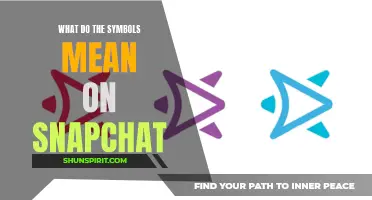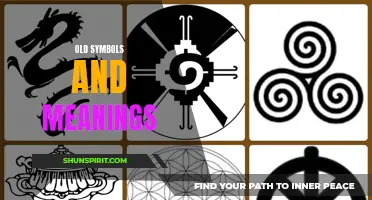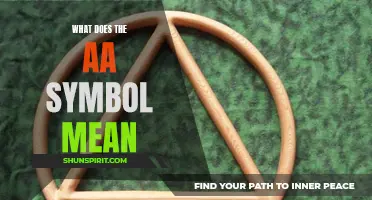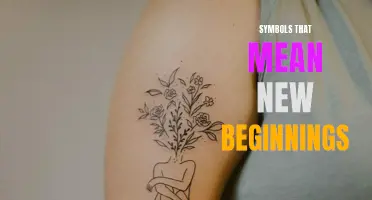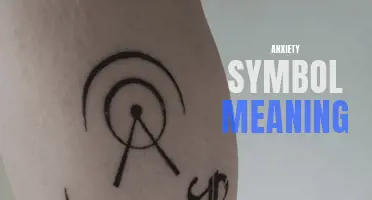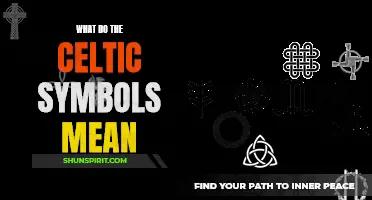Emoticons have revolutionized the way we communicate in the digital age, acting as visual cues to convey emotions that words often struggle to express. From the simplicity of a smiling face to the complexity of a sequence of characters, each emoticon symbol holds a unique meaning that transcends language barriers and allows us to connect and understand one another in the digital realm. In this article, we will explore the fascinating world of emoticon symbol meanings, understanding the origins and interpretations behind these tiny, yet powerful, virtual illustrations. So, let's dive into the world of emoticons and unravel the hidden messages behind these expressive symbols.
What You'll Learn
- What are some common emoticon symbols and their meanings?
- How do emoticon symbols differ from emoji symbols?
- Are there cultural differences in the meaning of emoticon symbols?
- Can the meaning of an emoticon symbol change over time or in different contexts?
- How do different platforms or devices affect the interpretation of emoticon symbols?

What are some common emoticon symbols and their meanings?
Emoticons are a popular form of communication in online chats, text messages, and social media posts. These symbolic representations of facial expressions allow people to express their feelings and emotions without relying solely on words. Emoticons can help convey tone, humor, sarcasm, and other nuances in online conversations. In this article, we will explore some common emoticon symbols and their meanings.
- :) or :-) - This is the classic smiling emoticon symbol. It represents happiness, friendliness, or a general positive sentiment. The bigger the smile, the happier the person is.
- :( or :-( - This is the opposite of the smiling emoticon, representing sadness, disappointment, or a negative emotion. The bigger the frown, the sadder the person is.
- :D or :-D - This emoticon symbol represents extreme happiness or excitement. The "D" stands for a big open mouth or a wide smile.
- ;) or ;-) - The winking emoticon symbol represents a playful or mischievous tone. It can imply humor, sarcasm, or a hidden meaning in the message.
- :P or :-P - This emoticon symbol represents a tongue sticking out in a playful or teasing manner. It is often used to indicate joking, silliness, or tongue-in-cheek comments.
- :O or :-O - This emoticon symbol signifies shock, surprise, or disbelief. The "O" represents a wide-open mouth expressing astonishment.
- :/ or :-/ - This emoticon symbol represents uncertainty, skepticism, or hesitation. It can indicate that the person is not entirely convinced or unsure about something.
- :| or :-| - This emoticon symbol represents neutrality, indifference, or a lack of emotion. It can indicate that the person is neither happy nor sad about a particular situation.
- :') or :'( - This emoticon symbol represents crying or tears of joy. The apostrophes represent the eyes, and the brackets represent the tears.
- <3 - This emoticon symbol represents a heart shape, symbolizing love, affection, or friendship. It is often used to express love for someone or something.
It is essential to note that emoticons are subjective, and their meanings may vary depending on the context or the individual using them. Some people may use different emoticons to convey similar emotions, or they may combine multiple symbols to express a more complex sentiment. Also, consider the cultural differences as some emoticons can have different interpretations in different cultures.
Overall, emoticons add a personal touch to online communication and help bridge the gap between written words and actual emotions. They can enhance the understanding and emotional connection in online interactions, making them a valuable tool in modern communication.
The Meaning Behind the Empathy Symbol: Understanding the Power of Compassion
You may want to see also

How do emoticon symbols differ from emoji symbols?
Emoticons and emoji symbols are popular ways to add emotion and visual elements to online communication. While there may be some confusion about the differences between these two types of symbols, they are actually distinct in their origins and usage.
Emoticons, short for "emotion icons," are expressive symbols created using ASCII characters. They were first introduced in the 1980s when computer users began using text-based communication platforms. Emoticons are typically created by combining punctuation marks, letters, and numbers to form simple facial expressions. For example, the classic smiley face :) or frowning face :( are common emoticons that represent happiness and sadness, respectively. Emoticons rely on the user's imagination to interpret the intended emotion, as they are static symbols with limited visual representation.
On the other hand, emoji symbols originated in Japan in the late 1990s and have gained significant popularity worldwide since then. Unlike emoticons, emojis are pictorial representations of emotions, objects, and concepts. They are vibrant, colorful, and often animated. Emojis are created using Unicode characters, which means that they are standard across different platforms and devices. This allows users to send and receive emojis on various messaging apps and social media platforms without compatibility issues.
Emojis offer a wide range of symbols that cover a broader scope of emotions and objects compared to emoticons. There are various categories of emojis, including facial expressions, animals, food, and activities. For instance, an emoji with tears of joy 😂 represents intense laughter, while a heart emoji ❤️ symbolizes love and affection. Emojis also enhance online communication by offering a visual representation that is easy to understand and interpret, eliminating any ambiguity in conveying emotions.
Additionally, while emoticons are limited to simple representations using characters found on a keyboard, emojis can depict more complex and specific ideas. For example, an emoji of a hospital 🏥 or a syringe 💉 can convey the concept of health or medical emergencies. Emojis have become so popular that they have even influenced popular culture, with movies, merchandise, and even an emoji-themed movie released in recent years.
In conclusion, emoticons and emojis both serve the purpose of expressing emotions and adding visual elements to online communication. However, emoticons are created using ASCII characters and rely on the user's imagination, while emojis are standardized, colorful images created with Unicode characters. Emojis offer a wider range of symbols, covering various emotions and objects, making them more versatile and universally understood in today's digital world.
Decoding the Mystery: Unveiling the Meaning Behind Microwave Symbols
You may want to see also

Are there cultural differences in the meaning of emoticon symbols?
Emoticons have become an integral part of our digital communication, allowing us to convey emotions and express ourselves quickly and effectively. However, the meaning behind these symbols can vary across different cultures, leading to potential misunderstandings.
Cultural differences play a significant role in how people interpret and understand emoticons. What may be seen as positive or neutral in one culture could be perceived as negative or offensive in another. For example, the use of a smiling or laughing emoticon may be seen as a friendly gesture in Western cultures, but in some Eastern cultures, it can be associated with insincerity or mockery.
In addition to cultural nuances, language also plays a crucial role in the interpretation of emoticons. Emoticons are often used to supplement text-based messages, adding emotional context to the words. However, different languages have different ways of expressing emotions, leading to variations in the interpretation of emoticons. While a specific emoticon may convey happiness in English, it might represent a different emotion in another language.
Religious and regional cultural differences further impact the interpretation of emoticons. Certain symbols or gestures may hold different meanings or connotations in different religious or regional contexts. For instance, the "thumbs up" gesture is widely recognized as a positive symbol in Western cultures, but it may signify a rude or offensive gesture in some Middle Eastern countries.
Historical and societal factors also influence the meaning of emoticons in different cultures. For example, cultural events or political situations may shape the interpretation of certain symbols. As a result, an emoticon that is harmless or neutral in one culture could be deemed offensive or inappropriate in another.
To avoid misunderstandings and misinterpretations, it is essential to be cautious when using emoticons across different cultural contexts. When communicating with individuals from different cultural backgrounds, it is advisable to consider their cultural norms and preferences. It is always better to err on the side of caution and use more universally understood symbols, such as the smiley face or simple expressions, which are less likely to be misinterpreted.
In conclusion, cultural differences play a significant role in the interpretation and meaning of emoticons. What may be seen as positive or neutral in one culture could be perceived differently in another. Language, religious beliefs, regional differences, and historical factors all contribute to the varying interpretations of emoticons. To avoid misunderstandings, it is important to be mindful of cultural differences when using emoticons in cross-cultural communication.
The Rich and Symbolic Meaning of the Chinese Dragon
You may want to see also

Can the meaning of an emoticon symbol change over time or in different contexts?
Emoticons have become an integral part of online communication, allowing individuals to express their emotions and convey meaning without the use of spoken words. These symbols have proven to be especially useful in the digital age, where written communication has taken precedence over face-to-face interactions. However, the meanings behind emoticons are not set in stone and can change over time or in different contexts.
One of the primary reasons why the meanings of emoticons can change is due to cultural differences. Emoticons are a reflection of the society in which they are used, and different societies may interpret symbols differently. For example, a smiley face :) may be seen as friendly and inviting in Western cultures, but in some Eastern cultures, it is seen as overly familiar and insincere. As a result, the meaning of the symbol can vary depending on the cultural context in which it is used.
Additionally, the rise of memes and internet culture has led to the creation of new emoticons and altered meanings. Memes are often based on inside jokes or references to popular culture, and these references can be incorporated into emoticons. As a result, the meaning of an emoticon can change if it is associated with a particular meme or internet trend. For example, the symbol :/ traditionally represents confusion or uncertainty, but in the context of memes, it can be used to indicate a sarcastic or cynical response.
Furthermore, the evolution of language and technology can also influence the meanings of emoticons. New symbols and graphics are constantly being developed to represent specific emotions or actions, and these additions can alter the meanings of existing emoticons. For example, the symbol :D originally represented a wide smile, but with the introduction of the XD symbol, which represents an exaggerated laugh, the meaning of :D has shifted to represent moderate amusement. The introduction of new emojis, which are more detailed and visually expressive than traditional emoticons, also adds new layers of meaning to online communication.
In conclusion, the meaning of an emoticon symbol can change over time or in different contexts due to cultural differences, internet trends, and technological advancements. As online communication continues to evolve, so too will the meanings behind the symbols we use to express ourselves. It is important to remain aware of these changes to ensure effective and accurate communication in the digital age.
Uncovering the Deeper Meaning Behind the NM Zia Symbol
You may want to see also

How do different platforms or devices affect the interpretation of emoticon symbols?
Emoticons are a form of visual communication that have become an integral part of our digital conversations. They help convey emotions and add depth and nuance to our written messages. However, despite their widespread usage, the interpretation of emoticon symbols can vary depending on the platform or device used.
Different platforms, such as social media apps and messaging platforms, often have their own set of emoticons. For example, the smiling face emoticon ":)" may look slightly different on Facebook compared to how it appears on WhatsApp or Twitter. These subtle variations can sometimes lead to confusion or misinterpretation of the intended emotion. What may be interpreted as a friendly smile on one platform can be perceived as sarcastic on another.
In addition to platform differences, the interpretation of emoticon symbols can also be influenced by the device used to view them. Emoticons may appear differently on an iPhone compared to an Android phone, or on a desktop computer compared to a tablet. This is because each device has its own operating system and set of fonts, which can affect the design and appearance of emoticon symbols.
Furthermore, the size and resolution of the screen also play a role in how emoticons are interpreted. A small emoticon on a mobile device screen may not convey the same level of detail and expression as it would on a larger screen. This can lead to confusion or misunderstanding, as the intended emotion may not come across clearly.
Another factor to consider is cultural differences in emoticon interpretation. Certain emoticons may have different meanings or connotations in different cultures. For example, a thumbs-up emoticon may be interpreted as a positive gesture in Western cultures, but it can be considered offensive or rude in some Asian cultures.
To minimize misunderstandings and misinterpretations, it is important to consider the context and platform when using emoticon symbols. Being mindful of the audience and platform can help ensure that the intended emotion is properly conveyed. Additionally, providing additional context or using words to describe the emotion can also help clarify the intended meaning.
In conclusion, the interpretation of emoticon symbols can be influenced by the platform or device used. Variations in design, appearance, and cultural context can lead to different interpretations of the same emoticon. Being aware of these differences and using additional context when necessary can help ensure effective communication and minimize misunderstandings in our digital conversations.
The Symbolic Meaning of the Starfish: A Deep Dive into its Spiritual Significance
You may want to see also
Frequently asked questions
The smiley face emoticon ":)" typically represents happiness, joy, or friendliness. It is commonly used to indicate that something is funny or to display a positive attitude.
The wink emoticon ";)" is often used to suggest humor, flirtation, or playfulness. It is typically used to imply a hidden meaning or to indicate that the sender is joking in a lighthearted manner.
The crying emoticon ":'(" represents sadness, grief, or disappointment. It is commonly used to convey a feeling of deep sadness or to express sympathy for someone's loss or unhappiness.
The tongue sticking out emoticon ":P" is often used to indicate playfulness, teasing, or sarcasm. It is commonly used to make a joke or to be silly in a lighthearted manner. This emoticon is often used to indicate that the sender is not being serious or is being intentionally exaggerated.


